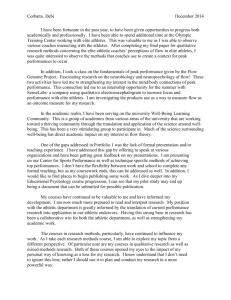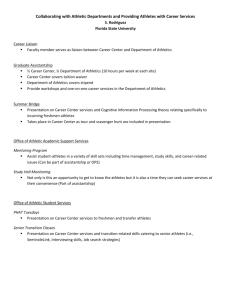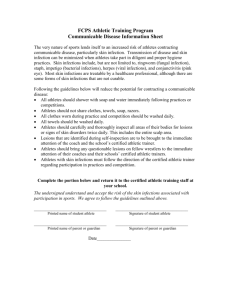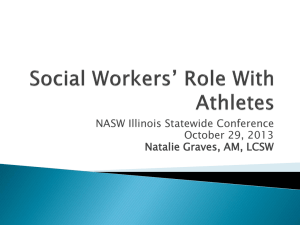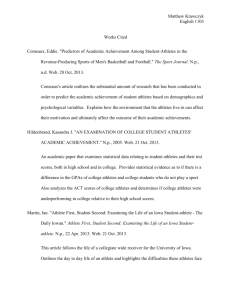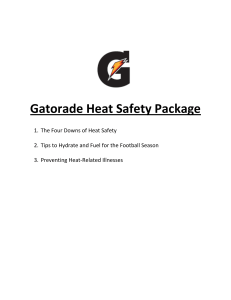Heat and Humidity
advertisement
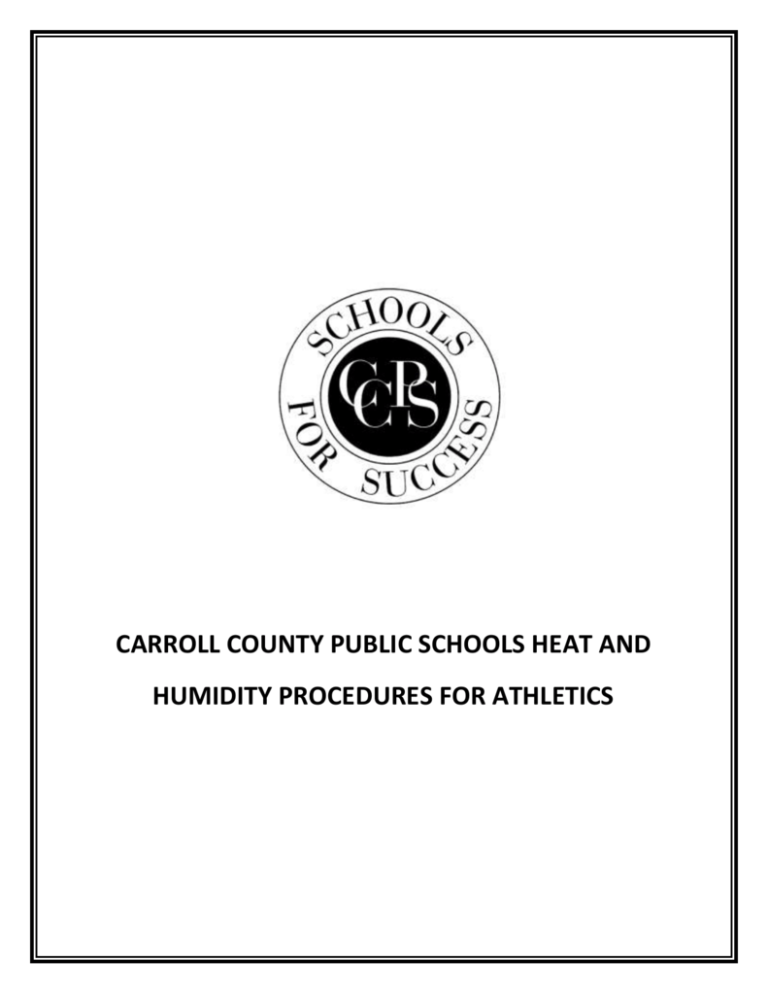
CARROLL COUNTY PUBLIC SCHOOLS HEAT AND HUMIDITY PROCEDURES FOR ATHLETICS CCPS SPONSORED ATHLETIC EVENTS (Practices and Contests): It is each coach’s responsibility to be trained, understand and follow the heat and humidity procedures. The athletic directors and administrators at each school should monitor the coaches to ensure they respond appropriately. Coaches will evaluate weather related conditions either by direct measurement on site or through internet services with conditions at the nearest zip code. This should be done before practice begins and as conditions warrant. All efforts will be made by the Supervisor of Athletics to monitor the weather conditions and notify coaches, athletic directors and school administrators via Alert Now should restrictions or cancellations become necessary. However, if coaches, athletic directors or school administrators are not notified but are aware of potentially unsafe conditions, they are expected to follow code restrictions. CONSULT THESE WEBSITES FOR DAILY UPDATES: Accu Weather – www.accuweather.com The Weather Channel – www.weather.com The National Weather Service – www.srh.noaa.gov Air Quality Index – www.airnow.gov AIR QUALITY CHART The following chart is but one chart used to determine limitations posed on athletic activities. In game situations, game officials and administrators on duty, in consultation with certified trainers and coaches, will make decisions on heat index & air quality. Air Quality Readings Reading Classification Code 0-100 Good to Moderate Blue 100-200 Unhealthy Green 201-300 Very Unhealthy Yellow Over 300 Hazardous Red The Carroll County Public School System HEAT INDEX Relative Humidity (%) 68 70 72 74 76 78 80 82 84 86 88 90 92 94 96 98 100 102 104 0 61 64 66 68 70 75 77 79 79 81 82 84 84 86 90 90 91 93 95 10 63 64 66 68 72 75 77 79 81 82 84 84 84 88 91 93 95 97 99 20 63 66 68 70 72 77 79 81 81 82 84 86 86 90 95 97 99 100 104 30 64 66 68 72 73 79 79 81 82 84 86 88 88 93 99 100 104 106 109 40 66 68 70 72 73 79 81 82 84 86 88 91 91 97 102 106 111 115 120 50 66 68 70 73 75 81 81 84 86 88 91 95 97 100 109 115 120 129 138 60 68 70 72 73 75 81 82 84 88 91 95 99 102 108 120 129 135 70 68 70 72 75 77 81 84 88 91 95 99 104 109 117 136 80 70 72 73 75 77 82 86 90 95 99 104 111 120 131 90 70 72 73 75 79 84 88 93 99 104 113 124 136 100 70 72 73 77 79 86 91 97 104 113 127 144 The above heat index chart is provided by the National Weather Service. The combination of air temperature (Fahrenheit degrees) and relative humidity (percent) produce a reading of how the air feels to human flesh or the apparent temperature. The heat index (apparent temperature) for a particular day will dictate any cancellations or restricted game and practice conditions. See the next page for specific restrictions. The Carroll County Public School System Game/Practice Restrictions Due to Heat Heat Index Reading 105+ Color/Code Code Red 95-104 Code Yellow 84-94 Code Green Below 83 Code Blue Restriction Danger! Discontinue regular practice. All outside athletic events are to be cancelled. Practice indoors if possible. Extreme Caution! Modify practice with frequent (required) water breaks. Games/events may continue with mandatory official timeouts midway through quarters. Provide a water stop (mandatory) midway in XC meets. Observe athletes carefully for signs of heat injuries. Make sure all athletes drink water. Warning. Provide a mandatory 10 minutes rest per 45 minutes of activity. Water is to be available to athletes at all times. No restrictions. Water is to be available at all times. Monitor the heat index for increases. NOTE: A “Code yellow or red” alert will be issued if necessary. Coaches are to follow the specific guidelines indicated for the “code”. On nonschool days, the coach will receive Alert Now practice and game alerts. As a final back up, the coach may call 410-936-1212 (National Weather Service) to receive temperature, relative humidity, and air quality readings. HEAT RELATED ILLNESS: SIGNS AND SYMPTOMS ILLNESS SYMPTOMS FIRST AID RETURN TO PLAY Heat Cramps (Mild ) Involuntary Muscle Spasms Hydration Stretching Relaxation Massage Symptom Free Monitor Carefully Heat Exhaustion (Moderate) Headache, nausea, vomiting, chills, dizziness, rapid pulse, cool or clammy skin, pale, excessive sweating Shade or AC Remove excessive clothes/equipment Lie with feet above heart Rehydrate if no nausea Monitor HR, BP CNS status and core temperature Symptom Free Avoid intense activity for several days If medical treatment was sought must have doctor’s release to return Heat Stroke (Medical Emergency) Disorientation, slurred Speech, confusion or aggressive behavior, dry skin, flushed and hot skin, rapid/ pounding pulse Call 911 Aggressive whole body cooling (cold water immersion) Fans, Ice, Cold towels if immersion is not available Only with doctor release and specific return to play instructions Return slowly under supervision of Health Care Professional INSTRUCTIONS TO ATHLETES: Athletes will be instructed to remove themselves from any athletic activity if they feel overheated. If an athlete has any symptoms of heat related illness, he/she will be removed from any athletic activity and given reasonable and prudent immediate care by the training and/or coaching staff. The athlete’s parent/guardian will be notified and advised to contact their physician or go to the local emergency room if symptoms persist or worsen. Athletes with any heat related illness will be re-evaluated by the Certified Athletic Trainer before being allowed to return to activity. The coach will verify the athlete’s practice status with the certified athletic trainer prior to the athlete returning to activity. PREVENTION OF HEAT RELATED ILLNESS: a. b. c. d. e. f. g. h. i. j. k. l. Allow unlimited access to water/fluids at all practices and games. Watch players who have high body fat; have to work harder for same results. Watch players who have smaller bodies; less surface area to get rid of heat. Watch those with more clothing/equipment; the heat is trapped against their bodies. Encourage athletes to drink fluids at the same rate that they lost them (work hard, drink a lot). Talk to athletes and coaches in preseason about prevention of heat illness. Discourage weight loss if it is only fluid loss (wrestlers, etc). Set up a weight chart and have players weigh in/out/in before practice; measure fluid loss. Check urine; concentrated urine means dehydrated, clear means hydration. Those who are not acclimatized are at greater risk. Acclimatization is the process where the body learns to function more efficiently in the heat. For example, in the spring 75 degrees feels warm, but when you are acclimatized to the heat in the summer 75 degrees feels cold! Those athletes who are in poor physical condition are at higher risk. For example, the ones who did not do summer conditioning are at greater risk in the fall. Athletes who have been ill, have a fever, or are recovering from an illness are at greater risk. FLUID REPLACEMENT: a. b. c. d. Athletes must drink past the point where their thirst is quenched. Fluids should be available freely to all athletes at all times. Athletes must replenish fluids to the weight they were before practice. Athletes should check their urine color before practice; if it is dark, they are still dehydrated and should drink before practice. e. Cold water is an excellent replacement fluid f. Fluids other than water: 1. Sports drinks are generally only necessary during long-term activities. They help replenish sugar and minerals lost in sweat. However, they are not harmful at any time. 2. Avoid drinks high in sugar (sodas) due to slow absorption. 3. Avoid drinks high in caffeine: tea, sodas, and coffee. They cause urination.
